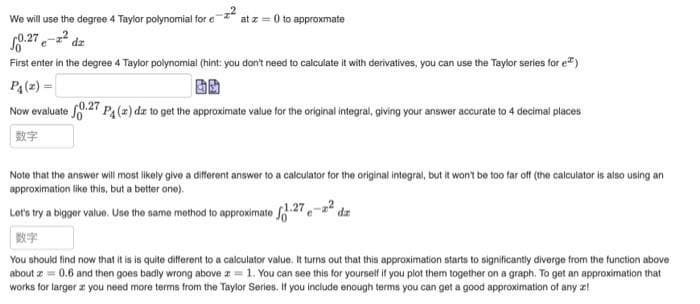We will use the degree 4 Taylor polynomial for e at z = 0 to approxmate First enter in the degree 4 Taylor polynomial (hint: you don't need to calculate it with derivatives, you can use the Taylor series for e) P₁(z)= Now evaluate 0.27 P4 (2) dz to get the approximate value for the original integral, giving your answer accurate to 4 decimal places 数字 Note that the answer will most likely give a different answer to a calculator for the original integral, but it won't be too far off (the calculator is also using an approximation like this, but a better one). Let's try a bigger value. Use the same method to approximate 1.27 -2² dz 数字 You should find now that it is is quite different to a calculator value. It turns out that this approximation starts to significantly diverge from the function above about = 0.6 and then goes badly wrong above z= 1. You can see this for yourself if you plot them together on a graph. To get an approximation that works for larger z you need more terms from the Taylor Series. If you include enough terms you can get a good approximation of any z1
We will use the degree 4 Taylor polynomial for e at z = 0 to approxmate First enter in the degree 4 Taylor polynomial (hint: you don't need to calculate it with derivatives, you can use the Taylor series for e) P₁(z)= Now evaluate 0.27 P4 (2) dz to get the approximate value for the original integral, giving your answer accurate to 4 decimal places 数字 Note that the answer will most likely give a different answer to a calculator for the original integral, but it won't be too far off (the calculator is also using an approximation like this, but a better one). Let's try a bigger value. Use the same method to approximate 1.27 -2² dz 数字 You should find now that it is is quite different to a calculator value. It turns out that this approximation starts to significantly diverge from the function above about = 0.6 and then goes badly wrong above z= 1. You can see this for yourself if you plot them together on a graph. To get an approximation that works for larger z you need more terms from the Taylor Series. If you include enough terms you can get a good approximation of any z1
Advanced Engineering Mathematics
10th Edition
ISBN:9780470458365
Author:Erwin Kreyszig
Publisher:Erwin Kreyszig
Chapter2: Second-order Linear Odes
Section: Chapter Questions
Problem 1RQ
Related questions
Question

Transcribed Image Text:We will use the degree 4 Taylor polynomial for e
0.276
e-² da
First enter in the degree 4 Taylor polynomial (hint: you don't need to calculate it with derivatives, you can use the Taylor series for e)
at z = 0 to approxmate
Now evaluate 0.27 P₁(x) da to get the approximate value for the original integral, giving your answer accurate to 4 decimal places
数字
Note that the answer will most likely give a different answer to a calculator for the original integral, but it won't be too far off (the calculator is also using an
approximation like this, but a better one).
Let's try a bigger value. Use the same method to approximate 1.27 -2² dz
|数字
You should find now that it is is quite different to a calculator value. It turns out that this approximation starts to significantly diverge from the function above
about = 0.6 and then goes badly wrong above z=1. You can see this for yourself if you plot them together on a graph. To get an approximation that
works for larger a you need more terms from the Taylor Series. If you include enough terms you can get a good approximation of any a
Expert Solution
This question has been solved!
Explore an expertly crafted, step-by-step solution for a thorough understanding of key concepts.
Step by step
Solved in 4 steps with 4 images

Recommended textbooks for you

Advanced Engineering Mathematics
Advanced Math
ISBN:
9780470458365
Author:
Erwin Kreyszig
Publisher:
Wiley, John & Sons, Incorporated

Numerical Methods for Engineers
Advanced Math
ISBN:
9780073397924
Author:
Steven C. Chapra Dr., Raymond P. Canale
Publisher:
McGraw-Hill Education

Introductory Mathematics for Engineering Applicat…
Advanced Math
ISBN:
9781118141809
Author:
Nathan Klingbeil
Publisher:
WILEY

Advanced Engineering Mathematics
Advanced Math
ISBN:
9780470458365
Author:
Erwin Kreyszig
Publisher:
Wiley, John & Sons, Incorporated

Numerical Methods for Engineers
Advanced Math
ISBN:
9780073397924
Author:
Steven C. Chapra Dr., Raymond P. Canale
Publisher:
McGraw-Hill Education

Introductory Mathematics for Engineering Applicat…
Advanced Math
ISBN:
9781118141809
Author:
Nathan Klingbeil
Publisher:
WILEY

Mathematics For Machine Technology
Advanced Math
ISBN:
9781337798310
Author:
Peterson, John.
Publisher:
Cengage Learning,

